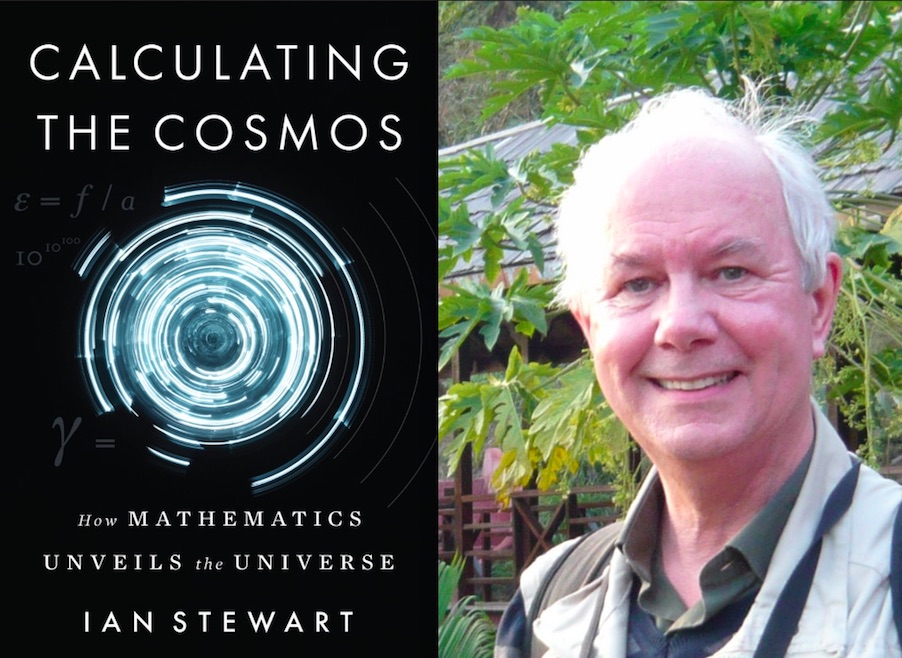Book Excerpt: 'Calculating the Cosmos' (US 2016)

In "Calculating the Cosmos," Ian Stewart presents an exhilarating guide to the cosmos, from our solar system to the entire universe. Beginning with the Babylonian integration of mathematics into the study of astronomy and cosmology, Stewart traces the evolution of our understanding of the cosmos: How Kepler's laws of planetary motion led Newton to formulate his theory of gravity. How, two centuries later, tiny irregularities in the motion of Mars inspired Einstein to devise his general theory of relativity. How, eighty years ago, the discovery that the universe is expanding led to the development of the Big Bang theory of its origins. How single-point origin and expansion led cosmologists to theorize new components of the universe, such as inflation, dark matter, and dark energy. But does inflation explain the structure of today's universe? Does dark matter actually exist? Could a scientific revolution that will challenge the long-held scientific orthodoxy and once again transform our understanding of the universe be on the way? Below is an excerpt from "Calculating the Cosmos: How Mathematics Unveils the Universe" (Basic Books, 2016).
These advances in space exploration and usage depend not just on clever technology, but also on a lengthy series of scientific discoveries that go back at least as far as ancient Babylon three millennia ago. Mathematics lies at the heart of these advances. Engineering is of course vital too, and discoveries in many other scientific disciplines were needed before we could make the necessary materials and assemble them into a working space probe, but I'll concentrate on how mathematics has improved our knowledge of the universe.
The story of space exploration and the story of mathematics have gone hand in hand from the earliest times. Mathematics has proved essential for understanding the Sun, Moon, planets, stars, and the vast panoply of associated objects that together form the cosmos – the universe considered on a grand scale. For thousands of years, mathematics has been our most effective method of understanding, recording, and predicting cosmic events. Indeed in some cultures, such as ancient India around 500, mathematics was a sub-branch of astronomy. Conversely, astronomical phenomena have influenced the development of mathematics for over three millennia, inspiring every- thing from Babylonian predictions of eclipses to calculus, chaos, and the curvature of spacetime.
Initially, the main astronomical role of mathematics was to record observations and perform useful calculations about phenomena such as solar eclipses, where the Moon temporarily obscures the Sun, or lunar eclipses, where the Earth’s shadow obscures the Moon. By thinking about the geometry of the solar system, astronomical pioneers realised that the Earth goes round the Sun, even though it looks the other way round from down here. The ancients also combined observations with geometry to estimate the size of the Earth and the distances to the Moon and the Sun.
Deeper astronomical patterns began to emerge around 1600, when Johannes Kepler discovered three mathematical regularities – 'laws' – in the orbits of the planets. In 1679 Isaac Newton reinterpreted Kepler’s laws to formulate an ambitious theory that described not just how the planets of the solar system move, but the motion of any system of celestial bodies. This was his theory of gravity, one of the central discoveries in his world-changing Philosophiae Naturalis Principia Mathematica (Mathematical Principles of Natural Philosophy). Newton's law of gravity describes how each body in the universe attracts every other body.
By combining gravity with other mathematical laws about the motion of bodies, pioneered by Galileo a century earlier, Newton explained and predicted numerous celestial phenomena. More generally, he changed how we think about the natural world, creating a scientific revolution that is still powering ahead today. Newton showed that natural phenomena are (often) governed by mathematical patterns, and by understanding these patterns we can improve our understanding of nature. In Newton's era the mathematical laws explained what was happening in the heavens, but they had no significant practical uses, other than for navigation.
***
Get the world’s most fascinating discoveries delivered straight to your inbox.
All that changed when the USSR's Sputnik satellite went into low Earth orbit in 1957, firing the starting gun for the space race. If you watch football on satellite television – or opera or comedies or science documentaries – you're reaping a real-world benefit from Newton's insights.
Initially, his successes led to a view of the cosmos as a clockwork universe, in which everything majestically follows paths laid down at the dawn of creation. For example, it was believed that the solar system was created in pretty much its current state, with the same planets moving along the same near-circular orbits. Admittedly, everything jiggled around a bit; the period's advances in astronomical observations had made that abundantly clear. But there was a widespread belief that nothing had changed, did change, or would change in any dramatic manner over countless eons. In European religion it was unthinkable that God's perfect creation could have been different in the past. The mechanistic view of a regular, predictable cosmos persisted for three hundred years.
No longer. Recent innovations in mathematics, such as chaos theory, coupled to today's powerful computers, able to crunch the relevant numbers with unprecedented speed, have greatly changed our views of the cosmos. The clockwork model of the solar system remains valid over short periods of time, and in astronomy a million years is usually short. But our cosmic backyard is now revealed as a place where worlds did, and will, migrate from one orbit to another. Yes, there are very long periods of regular behaviour, but from time to time they are punctuated by bursts of wild activity. The immutable laws that gave rise to the notion of a clockwork universe can also cause sudden changes and highly erratic behaviour.
The scenarios that astronomers now envisage are often dramatic. During the formation of the solar system, for instance, entire worlds collided with apocalyptic consequences. One day, in the distant future, they will probably do so again: there's a small chance that either Mercury or Venus is doomed, but we don’t know which. It could be both, and they could take us with them. One such collision probably led to the formation of the Moon. It sounds like something out of science fiction, and it is ... but the best kind, 'hard' science fiction in which only the fantastic new invention goes beyond known science. Except that here there is no fantastic invention, just an unexpected mathematical discovery.
Mathematics has informed our understanding of the cosmos on every scale: the origin and motion of the Moon, the movements and form of the planets and their companion moons, the intricacies of asteroids, comets, and Kuiper belt objects, and the ponderous celestial dance of the entire solar system. It has taught us how interactions with Jupiter can fling asteroids towards Mars, and thence the Earth; why Saturn is not alone in possessing rings; how its rings formed to begin with and why they behave as they do, with braids, ripples, and strange rotating 'spokes'. It has shown us how a planet’s rings can spit out moons, one at a time.
Clockwork has given way to fireworks.
Excerpted from "Calculating the Cosmos: How Mathematics Unveils the Universe"by Ian Stewart. Copyright © 2016. Available from Basic Books, an imprint of Perseus Books, LLC, a subsidiary of Hachette Book Group, Inc. All rights reserved.



